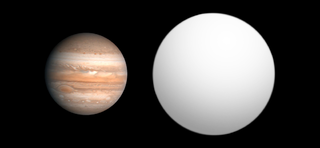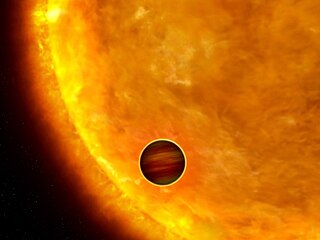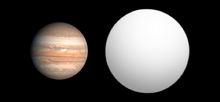
CoRoT was a space telescope mission which operated from 2006 to 2013. The mission's two objectives were to search for extrasolar planets with short orbital periods, particularly those of large terrestrial size, and to perform asteroseismology by measuring solar-like oscillations in stars. The mission was led by the French Space Agency (CNES) in conjunction with the European Space Agency (ESA) and other international partners.
A super-Jupiter is a gas giant exoplanet that is more massive than the planet Jupiter. For example, companions at the planet–brown dwarf borderline have been called super-Jupiters, such as around the star Kappa Andromedae.

WASP-1b is an extrasolar planet orbiting the star WASP-1 located 1,300 light-years away in the constellation Andromeda.
HD 147506, also known as HAT-P-2 and formally named Hunor, is a magnitude 8.7 F8 dwarf star that is somewhat larger and hotter than the Sun. The star is approximately 419 light-years from Earth and is positioned near the keystone of Hercules. It is estimated to be 2 to 3 billion years old, towards the end of its main sequence life. There is one known transiting exoplanet, and a second planet not observed to transit.

CoRoT-1b is a transiting extrasolar planet approximately 2,630 light-years away in the constellation of Monoceros. The planet was discovered orbiting the yellow dwarf star CoRoT-1 in May 2007. The planet was the first discovery by the French-led CoRoT Mission.

HAT-P-6b is a transiting extrasolar planet discovered by Noyes et al. on October 15, 2007. It is located approximately 910 light-years away in the constellation of Andromeda, orbiting the star HAT-P-6. This hot Jupiter planet orbits with a semi-major axis of about 7.832 gigameters, and takes 92 hours, 28 minutes, 17 seconds and 9 deciseconds to orbit the star. It has true mass of 5.7% greater than Jupiter and a radius 33% greater than Jupiter, corresponding to a density of 0.583 g/cm3, which is less than water.

CoRoT-3b is a brown dwarf or massive extrasolar planet with a mass 21.66 times that of Jupiter. The object orbits an F-type star in the constellation of Aquila. The orbit is circular and takes 4.2568 days to complete. It was discovered by the French-led CoRoT mission which detected the dimming of the parent star's light as CoRoT-3b passes in front of it.

CoRoT-5b is an extrasolar planet orbiting the F type star CoRoT-5. It was first reported by the CoRoT mission team in 2008 using a transit method. This planet has been confirmed by a Doppler follow-up study.

CoRoT-7b is an exoplanet orbiting the star CoRoT-7 in the constellation of Monoceros, 489 light-years from Earth. It was first detected photometrically by the French-led CoRoT mission and reported in February 2009. Until the announcement of Kepler-10b in January 2011, it was the smallest exoplanet to have its diameter measured, at 1.58 times that of the Earth and the first potential extrasolar terrestrial planet to be found. The exoplanet has a very short orbital period, revolving around its host star in about 20 hours.

CoRoT-1 is a yellow dwarf main sequence star similar to the Sun. The star is located approximately 2,630 light-years away in the constellation of Monoceros. The apparent magnitude of this star is 13.6, which means it is not visible to the naked eye; however, it can be seen through a medium-sized amateur telescope on a clear, dark night. The first exoplanet discovered in the course of the CoRoT mission orbits this star; it is considered to be a "hot Jupiter", and is approximately as massive as the planet Jupiter itself.
CoRoT-2 is a yellow dwarf main sequence star a little cooler than the Sun. This star is located approximately 700 light-years away in the constellation of Aquila. The apparent magnitude of this star is 12, which means it is not visible to the naked eye but can be seen with a medium-sized amateur telescope on a clear dark night.
CoRoT-7 is a binary star system.
CoRoT-21b is a transiting exoplanet reportedly found by the CoRoT space telescope in 2011. Planetary parameters were published in 2012.
CoRoT-18b is a transiting Hot Jupiter exoplanet found by the CoRoT space telescope in 2011.
CoRoT-20b is a transiting exoplanet found by the CoRoT space telescope in 2011.










